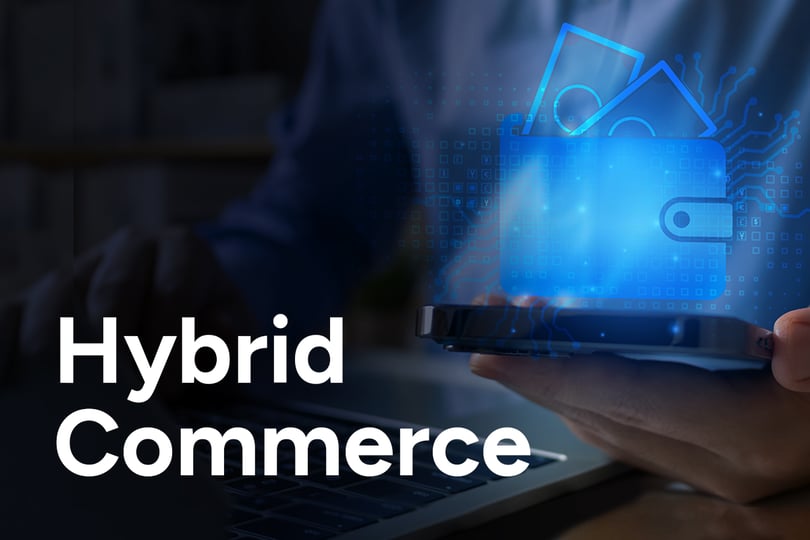Merging in-store and online retail: why hybrid commerce is the next big thing

Today’s consumers are hard to please. Spoilt for choice, strapped for time, and with smart technology at their fingertips, they’ve come to expect a shopping experience that’s highly personalized and hassle-free, providing (almost) instant gratification. Shopping on the go, hunting bargains online while browsing in-store, playing moving targets for delivery – it’s all part of the game these days.
How can retailers keep up? By streamlining their operations to the point where their physical stores virtually merge with their online presence to create one seamless shopping experience. Hybrid commerce, as it’s called, may sound daunting at first, but it has quite a few things going for it.
What, exactly, is hybrid commerce?
Put simply, hybrid commerce is the fusion of online and offline retail services in order to maximize shoppers’ convenience. This hybrid model requires close coordination between a retailer’s web store or online storefront, its mobile app, and its physical points of sale. This way, a customer can complete a shopping journey, possibly spanning several channels, without a hitch. It’s similar to omnichannel commerce, but this latter involves even deeper integration and a broader set of touchpoints, including, for instance, social media platforms.
Hybrid commerce comes in many shapes and forms. It can be a loyalty scheme that rewards both online and offline purchases – Sephora’s “Beauty Insider” program is a great example. Enabling shoppers to check a product’s in-store availability online is also part of the hybrid model. Walmart, Target, and other megastores have introduced click-and-collect, the option to buy items online and pick them up at the nearest store, as another way to dovetail offline and online commerce for greater convenience.
More sophisticated hybrid solutions include Nike’s augmented reality and mobile checkout to enhance in-store shopping experience. Brands selling their wares on online marketplaces as well as through their own physical network can also embrace the hybrid approach – for instance, with real-time inventory management across all channels.
Why the hybrid model is gaining traction in ecommerce
First and foremost, hybrid selling appeals to retailers because they need to make shopping as effortless as possible for their increasingly choosy customers. Bridging the gap between online and offline retail helps to achieve that. But another important benefit of hybrid commerce is being able to collect information about purchasing habits.
Every transaction, offline or online, informs brands about the individual tastes, choices, and habits of each customer. This, in turn, can translate into hyper-targeted marketing communication and personalized offers. Consumers have come to expect a high level of personalization from their favorite brands. In fact, it’s a must for retailers wishing to stay ahead of the competition – research shows that personalization fuels growth and boosts customer loyalty.
Implemented correctly, hybrid commerce solutions greatly broaden opportunities for data gathering, since they help to connect the dots between shoppers’ online and offline activity. In this case, data input from various channels adds up to create a more precise image of consumer behavior.
How online marketplaces fit into hybrid ecommerce
Many merchants choose to be present on online marketplaces like Amazon or eBay, in order to reach these platforms’ vast consumer base. In addition, some marketplaces provide fulfillment services to their sellers, freeing them up from the burden of logistics and warehousing.
For consumers, online marketplaces are increasingly becoming the default starting point for making purchases, doubling as search engines and price comparison tools – yet another reason to join them.
In short, selling on marketplaces can empower businesses to drive a strong hybrid commerce strategy and increase brand awareness, loyalty, revenue, and operational efficiency.
On the flip side, selling on online marketplaces presents its own set of challenges. Competition is fierce, as several sellers may be offering the same product. Cost savings must be weighed against the platform’s fees and commissions. Marketplaces update their algorithms and pricing models frequently, and keeping up with these changes requires a lot of legwork on the merchants’ part. Due to marketplaces’ power position and sellers’ race to the bottom, prices often dip below the profit line, particularly in case of low price-point items. Fixing this issue can be tricky, and, again, very labor-intensive. No wonder then that some businesses are cautious about adding online marketplaces to their hybrid commerce channels.
One way to overcome these obstacles is to join forces with a marketplace integrator like ChannelEngine. This comes especially handy for retailers who sell on several marketplaces, because an integrator pulls all those connections together into a single point of contact. It takes care of adopting algorithm updates and other technicalities, so retail brands can focus on their core functions. Nifty features like automated price rules help tailor sellers’ assortments to each marketplace: they allow setting a minimum margin and excluding items which fall below that, thus ensuring profitability on every sale.
Furthermore, by gaining easy access to a large number of online marketplaces, retailers can sell their own products on those platforms, instead of leaving it to distributors, who may put a dent in the brand image with low-res product shots or patchy descriptions.
How retailers can adopt the hybrid ecommerce model
Ready to embrace hybrid selling? Here are a few things to keep in mind before taking the leap.
To make the transition between physical and online sales channels as seamless as possible, your company needs a well-integrated tech stack: a powerful ecommerce platform, a point-of-sales system, and a CRM solution, all intimately connected. Not necessarily all managed in-house – read more about the modular approach to adopting new technologies.
Hybrid selling can put a strain on supply chain management: inventory levels can vary wildly across different channels depending on demand. Similarly, fulfillment centers may be under increased pressure to serve both online and offline customers to their ultimate satisfaction. Capturing and making sense of consumer data from multiple channels can also prove to be tricky. It’s wise to have robust solutions in place for all these functions.
In order to implement the hybrid ecommerce model successfully, it’s a good idea to start by assessing your current tech stack and operations. Once you’ve identified goals to reach through hybrid selling, define your strategy for creating a seamless shopping experience online and offline. Come up with a detailed roadmap of updates to your existing infrastructure, with a focus on integrating key tech platforms and optimizing your supply chain. It’s important to get your entire organization on board and to train staff to be able to embrace the hybrid approach.
Curious as to how this works in real life?
Read the story of how our client Brabantia benefitted from a hybrid ecommerce model involving multiple online marketplaces.
This article was contributed by Gabriella Vas.


